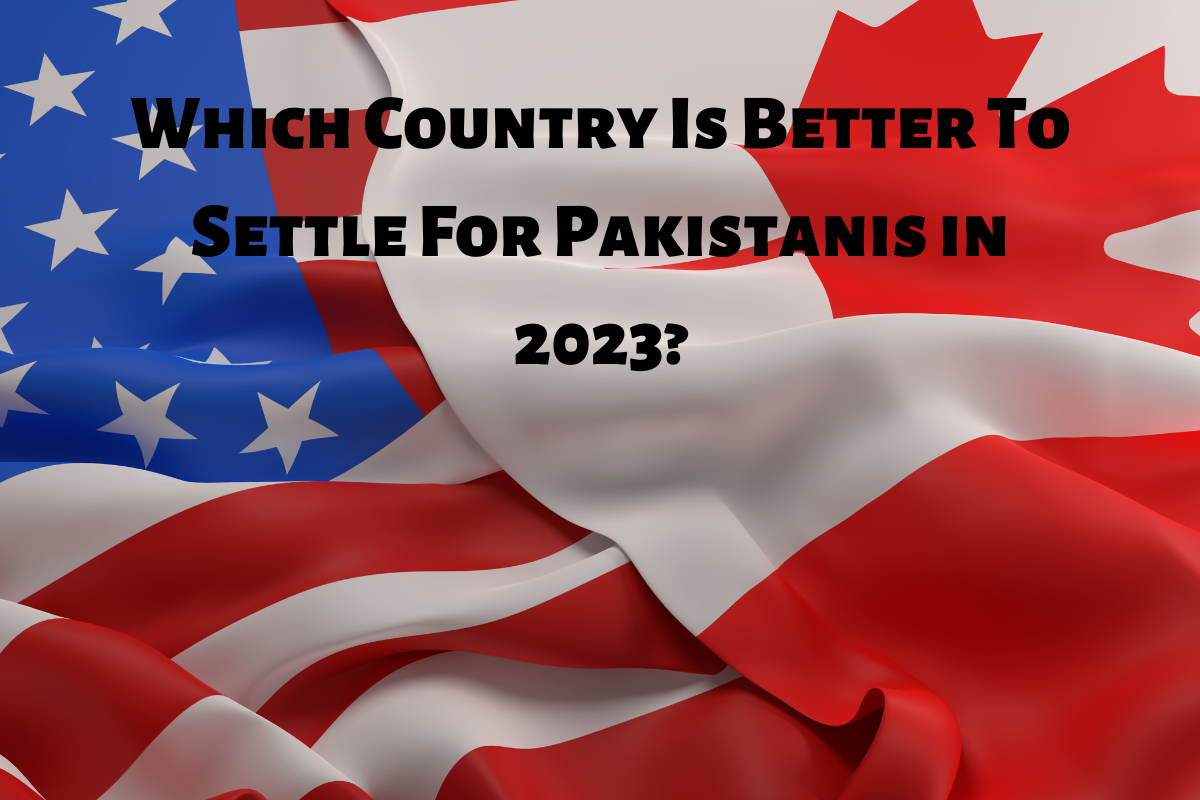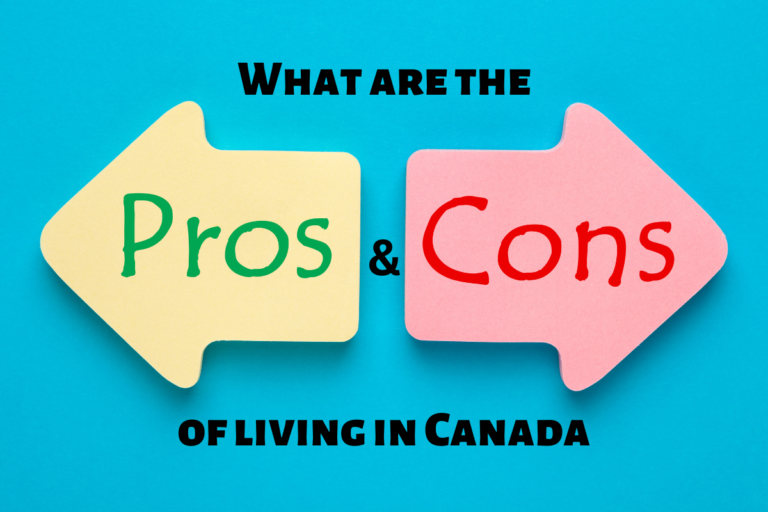Canada VS USA: Which Country Is Better To Settle For Pakistanis in 2023?
I can provide some information to help you make an informed decision.
Both Canada and the United States are developed countries and offer various opportunities for immigrants, including Pakistanis. However, there are some differences between the two countries that you may want to consider when deciding where to settle.
Canada is known for its welcoming and diverse culture, and it has a reputation for being a safe and peaceful country. The Canadian government has implemented several immigration programs that provide opportunities for skilled workers, entrepreneurs, and students to immigrate to Canada. Additionally, Canada offers free public healthcare, publicly funded education, and social services to its citizens and permanent residents.
On the other hand, the United States is a country with a large economy and many employment opportunities. However, the US immigration system can be complex and challenging to navigate, and it can take several years to obtain permanent residency or citizenship. The US also has a diverse culture and provides access to high-quality education and healthcare. However, these services can be expensive, and access can depend on your location and income.
Ultimately, the decision of where to settle depends on your individual circumstances and preferences. You may want to consider factors such as job opportunities, cost of living, healthcare, education, and cultural fit when making your decision.
Job Security and Average Work Hours
In terms of job security and average work hours, there are some differences between Canada and the United States.
Canada has strong labor laws that protect employees and provide job security. The Canadian Labour Code sets out minimum employment standards, including requirements for hours of work, overtime pay, and vacation entitlements. In addition, Canadian employees have the right to join a union and collectively bargain for better wages and working conditions. Overall, job security in Canada is relatively high, and there are strict regulations to protect workers.
In terms of average work hours, Canada has a maximum of 48 hours per week and mandates that employers provide at least one day of rest per week. However, many employees work fewer hours than the maximum, with the average workweek being around 37.5 hours.
In the United States, there is no federal law mandating a maximum number of work hours per week, and overtime pay is only required for hours worked over 40 per week. However, some states have their own labor laws that provide additional protections for workers. Job security can vary depending on the industry and employer, and there is generally less regulation around layoffs and termination.
Overall, Canada has stronger labor laws and provides more job security and regulated work hours, while the United States has a more flexible approach to work hours and employment practices.
Taxation
Taxation is an important consideration when deciding where to settle, as it can significantly impact your overall income and cost of living. Here are some key differences between Canada and the United States in terms of taxation:
In Canada, the federal government and provincial governments both collect taxes. The federal government collects income taxes, while the local governments collect their own income taxes, sales taxes, and property taxes. The federal income tax rates range from 15% to 33%, depending on your income level. The provincial income tax rates vary by province and range from approximately 5% to 21%.
In the United States, the federal government collects income taxes, and state governments collect their own income taxes and sales taxes. The federal income tax rates range from 10% to 37%, depending on your income level. State income tax rates vary by state and range from 0% to approximately 13.3%.
In both countries, there are deductions and credits available that can lower your overall tax burden. It is also worth noting that Canada has a publicly funded healthcare system, which is funded through taxes, while the United States has a more privatized healthcare system, which can result in higher out-of-pocket costs for individuals.
Overall, both countries have complex tax systems with varying rates and deductions, and the actual tax burden can depend on your individual circumstances. It is important to do your research and consult with a tax professional to fully understand your tax obligations in either country.
Education
Canada and the United States are both known for their high-quality education systems. Here are some key differences between the two countries in terms of education:
In Canada, education is publicly funded and overseen by provincial and territorial governments. The education system is divided into three levels: elementary, secondary, and post-secondary. Education is compulsory until the age of 16 or 18, depending on the province. The education system in Canada is highly regarded, and Canadian universities consistently rank among the top in the world.
In the United States, education is primarily funded through local property taxes and overseen by state and local governments. The education system is also divided into three levels: elementary, secondary, and post-secondary. Education is compulsory until the age of 16 or 18, depending on the state. The education system in the US is also highly regarded, with many top-ranked universities.
One notable difference between the two countries is the cost of post-secondary education. In Canada, post-secondary education is generally more affordable than in the US, with lower tuition fees and government funding options available for students. In the US, tuition fees for post-secondary education can be quite high, and students may need to take out loans to pay for their education.
Overall, both Canada and the United States have excellent education systems, and the actual quality of education can vary depending on the specific school or program. However, the cost of education is generally more affordable in Canada, making it an attractive option for students.
Immigration Pathways to Canada and The US
Both Canada and the United States offer several immigration pathways for individuals who wish to immigrate to these countries. Here are some of the main immigration pathways for each country:
Canada:
- Express Entry System: This is a points-based system that is used to manage applications for permanent residency under the Federal Skilled Worker Program, the Federal Skilled Trades Program, and the Canadian Experience Class.
- Provincial Nominee Program (PNP): This program allows provinces and territories to nominate candidates for permanent residency based on their specific economic and labor market needs.
- Family Sponsorship: Canadian citizens and permanent residents can sponsor their eligible family members for permanent residency in Canada.
- Business Immigration: There are several business immigration programs in Canada, including the Start-Up Visa Program, the Self-Employed Persons Program, and the Entrepreneur Program.
United States:
- Employment-Based Immigration: This pathway is designed for individuals who have a job offer in the United States and are sponsored by their employer.
- Family-Based Immigration: US citizens and permanent residents can sponsor their eligible family members for permanent residency in the United States.
- Diversity Visa Lottery: This program is a lottery-based system that provides a limited number of permanent residency visas to individuals from countries with historically low levels of immigration to the United States.
- Asylum and Refugee Status: Individuals who are fleeing persecution or danger in their home country may be eligible for asylum or refugee status in the United States.
- Investment-Based Immigration: This pathway is designed for individuals who invest a significant amount of money in a US business and create jobs for US workers.
Overall, both Canada and the United States offer a range of immigration pathways for individuals who wish to immigrate to these countries, and the specific pathway that is best for you will depend on your individual circumstances and qualifications.
Cost of Living: USA Vs Canada
The cost of living in the United States and Canada can vary widely depending on where you live and your individual circumstances. Here are some general differences between the two countries in terms of the cost of living:
- Housing: The cost of housing in the United States can vary widely depending on the location. In general, housing costs tend to be higher in major cities and coastal regions. In Canada, housing costs also vary by location but tend to be higher overall compared to the United States.
- Healthcare: Healthcare costs in Canada are generally lower than in the United States due to Canada’s publicly funded healthcare system. In the US, healthcare costs can be very high, especially for those without health insurance.
- Food and Groceries: The cost of food and groceries is generally similar in both countries, although specific prices may vary depending on the location and availability of certain products.
- Transportation: The cost of transportation, including gasoline and public transportation, tends to be slightly higher in Canada compared to the United States.
- Taxes: As mentioned earlier, taxes in Canada tend to be higher overall compared to the United States.
Overall, the cost of living can vary widely depending on where you live in either country and your individual circumstances. However, in general, Canada tends to have a slightly higher cost of living compared to the United States, primarily due to higher housing costs and taxes.
Challenges faced by Pakistanis Migrants
Pakistanis migrants face different challenges when migrating to the USA and Canada. Here are some of the challenges faced by Pakistanis migrants in each country:
Challenges faced by Pakistanis migrants in the USA:
- Discrimination: Pakistani migrants in the USA often face discrimination, particularly after the 9/11 attacks, and as a result, many Pakistanis feel unwelcome and isolated in the US.
- Language Barrier: Many Pakistanis migrants may not be fluent in English, which can make it difficult to communicate and navigate their new surroundings.
- Employment: Pakistani migrants in the USA often face challenges in finding jobs, and may have to work in low-paying jobs or take jobs that are below their qualifications.
- Immigration Policies: US immigration policies have become increasingly strict over the years, which has made it more difficult for Pakistanis migrants to obtain visas and residency.
- Cultural Differences: Pakistani migrants may struggle to adjust to cultural differences in the USA, including different customs, social norms, and lifestyles.
Challenges faced by Pakistanis migrants in Canada:
- Cold Weather: Canada has extremely cold weather, and many Pakistani migrants may struggle to adapt to the cold temperatures.
- Finding Employment: While Canada has a strong economy and low unemployment, finding employment can still be challenging for Pakistani migrants, particularly if they are not fluent in English or French.
- Language Barrier: Similar to the USA, many Pakistanis migrants may struggle with language barriers in Canada, which can make it difficult to integrate into Canadian society.
- Cultural Differences: Canadian culture is different from Pakistani culture, which can lead to cultural misunderstandings and difficulties adjusting to Canadian norms and values.
- Access to Services: Pakistani migrants may face challenges in accessing healthcare, education, and other services due to language barriers or a lack of knowledge about how the Canadian system works.
Overall, both the USA and Canada present unique challenges for Pakistani migrants, and it is important for individuals to carefully consider their options and research the potential challenges before making a decision to migrate to either country.




